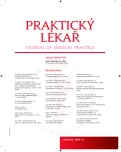On beauty
Authors:
F. Koukolík
Authors‘ workplace:
Primář: doc MUDr. Radoslav Matěj, PhD.
; Národní referenční laboratoř prionových chorob
; Thomayerova nemocnice, Praha
; Oddělení patologie a molekulární medicíny
Published in:
Prakt. Lék. 2014; 94(4): 165-171
Category:
Editorial
Overview
The term aesthetics is used broadly to encompass the perception, production, and response to art, as well as interactions with objects and scenes that evoke an intense feeling, often of pleasure. Neuroaesthetics is a young field of research concerned primarily with the neural basis of cognitive and affective processes engaged when an individual takes an aesthetic or artistic approach towards a work of art, a non-artistic object or a natural phenomenon. Contemporary neuroesthetics is made possible owing to functional imaging methods. There exist two systems of neural aesthetic evaluation and there exist a difference between pragmatic and aesthetic visual cognition. Human brain recognizes a difference between authentic picture and a picture labeled as its copy. There is a common cortical denominator of visual and musical beauty: the medial orbito-frontal cortex (mOFC). The activity produced by the experience of beauty derived from either source overlapping almost completely within it. The strength of activation in this part of the mOFC was proportional to the strength of the declared intensity of the experience of beauty. Magnetoencephalography proves gender differences in aesthetic experience. There are differences in assessment of the attractivity of human faces between females and males and between homosexual and heterosexual people. Human capability of distinguishing beauty could be an evolutionary adaptation.
Keywords:
neuroesthetics – common cortical denominator – aesthetic experience – beauty – adaptation
Sources
1. Brown S, Gao X, Tisdelle L, et al. Naturalizing aesthetics: brain areas for aesthetic appraisal across sensory modalities. NeuroImage 2011; 58 : 250–258.
2. Cataneo Z, Lega C, Flexas A, et al. The world can look better: enhancing beauty experience with brain stimulation. Soc Cogn Affect Neurosci 2013; [Epub ahead of print]. doi:10.1093/scan/nst165.
3. Cela–Conde CJ, Ayala FJ, Munar E, et al. Sex–related similarities and differences in the neural correlates of beauty. Proc Natl Acad Sci 2009; 106 : 3847–3852.
4. Cela-Conde CJ, Garcia-Prieto J, Ramasco J, et al. Dynamics of brain networks in the aesthetic appreciation. Proc Natl Acad Sci USA 2013; 110(Suppl 2): 10454–10461.
5. Fairhall SL, Ishai A. Neural correlates of object indeterminacy in art compositions. Conscious Cogn 2008; 17 : 923–932.
6. Huang M, Bridge H, Kemp MJ, et al. Human cortical activity evoked by the assignement of authenticity when viewing works of art. Front Hum Neurosci. 2011; 5 : 134. doi: 10.3389/fnhum.2011.00134.
7. Ishai A. Sex, beauty and the orbitofrontal cortex. Int J Psychophysiol 2007; 63 : 181–185.
8. Ishizu T, Zeki S. Toward a brain-based theory of beauty. PLoS ONE 2011; 6(7): e21852. doi:10.1371/journal.pone.0021852
9. Jacobsen T. Beauty and the brain: culture, history and individual differences in aesthetic appreciation. J Anat 2010; 216(2); 184–191.
10. Kirk U. The neural basis of object-context relationships aesthetic judgment. PLoS ONE 2008; 3(11): e3754. doi:10.1371/journal.pone.0003754.
11. Kirk U, Skov M, Hulme O, et al. Modulation of aesthetic value by semantic context: an fMRI study. NeuroImage 2009; 44 : 1125–1132.
12. Lengger PG, Fischmeister FPhS, Leder H, et al. Functional neuroanatomy of the perception of modern art: A DC-EEG study on the influence of stylistic information on aesthetic experience. Brain Res. 2007; 1158 : 93–102. doi:10.1016/j.brainres.2007.05.001.
13. Levy B, Ariely D, Mazar N, et al. Gender differences in the motivational processing of facial beauty. Learn Motiv 2008; 39 : 136–145.
14. Trost W, Ethofer T, Zentner M, et al. Mapping aesthetic musical emotion in the brain. Cereb Cortex 2011; 22(12): 2769–2783. doi:10.1093/cercor/bhr353.
15. Tsukiura T., Cabeza R. Shared brain activity for aesthetic and moral judgments: implications for the Beauty-is-Good stereotype. Soc Cogn Affect Neurosci 2011; 6(1): 138–148.
16. Vartanian O, Goel V. Neuroanatomical correlates of aesthetic preference for paintings. NeuroReport 2004; 15 : 893–897.
17. Vessel EA, Starr GG, Rubin N. The brain on art: intense aesthetic experience activates the default mode network. Front Hum Neurosci. 2012; 6 : 66. doi:10.3389/fnhum.2012.00066.
18. Wiesman M, Ishai A. Training facilitates object recognition in cubist paintings. Front Hum Neurosci 2010; doi: 10.3389/neuro.09.011.2010.
19. Yue X, Vessel EA, Biederman I. The neural basis of scene preferences. NeuroReport 2007; 18 : 525–529.
20. Zattore RJ, Salimpoor VN. From perception to pleasure: music and its neural substrates. Proc Natl Acad Sci 2013; 110 : 10430–10437.
Labels
General practitioner for children and adolescents General practitioner for adultsArticle was published in
General Practitioner

2014 Issue 4
Most read in this issue
- Arthritis of the wrist and possibilities of surgical treatment
- Pre-operative assessment and pre-operative preparation in lung surgery
- Posttraumatic stress disorder
- What is „third-hand smoke“?
